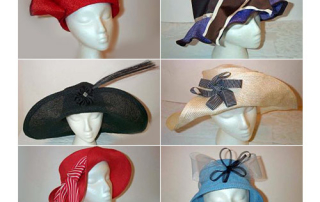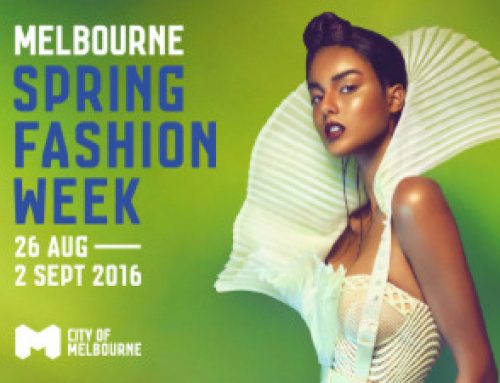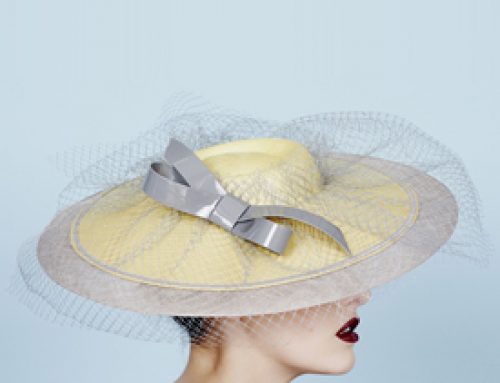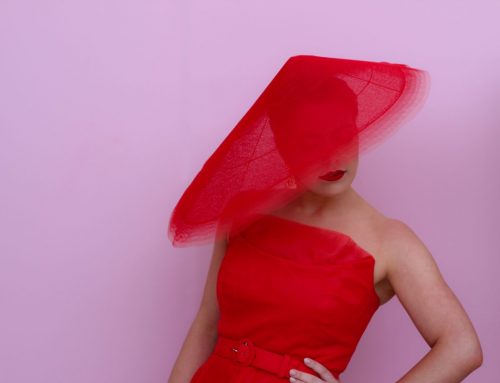How did you become interested in millinery?
I have always worn hats, continuing a tradition that started with my great-grandmother (in fact, I have a collection of turn of the century picture hats which were left to me by my great-grandmother). As young as 10, I started to alter my hats to suit me – either changing the brim or adding other trims. As I spent my formative years in New York City in the late 60s, 70s, I was fortunate to be part of a wonderful environment of changing styles, innovative designers and reveled in creating my own “look”. This continued through college where I “dressed” and created millinery for friends. While I pursued an advertising career in NYC after college, I continued to set my own style, hoping that one day I would be able to have the finances to try millinery as a business. I was able to go into business for myself 4 years ago. I am pleased to say that I have a growing custom business (one of my clients commissions 2 hats for Ascot every year) and a selection of retail stores in Connecticut and New York City.
Where did you learn millinery?
I am self-taught. I have always had an extensive collection of millinery and was always interested in discovering the internal workings of the designs. So I picked up “the tricks of the trade” by observation. Also, I applied my own ideas to create what was in my mind. My objective is always to minimize the mechanicals, so that the hat does not become too constructed and does not require the wearer to engage in any balancing act. Fashion becomes foolish when ease is replaced by self-consciousness.
How long have you been a milliner?
As I said earlier, I opened my business 4 years ago. Prior to that, I was in advertising on Madison Avenue in NYC for 17 years and then became manager for MOMIX, a dance-theater company, helping them with marketing and managing the business.
Where to you get inspirations for your designs?
I go to museums to see color combinations. Color combinations and patterns in nature are also important for me in the creating process. Is this any different from anyone else? The difference is how one processes the information. I have been an observer of all these things since childhood and I draw upon it when I set to work. I am never sure of what I will do, and all of my hats are one of a kind. With my custom clients, I get to know them and always want to know if there is a special occasion or dress that the hat will be worn for/with. That is the basis for my creating for those clients. Sometimes, I start out with one idea and the hat becomes something else entirely.
What has been your most enjoyable commission?
I recently made some hats for one of my clients who is always a fixture at Ascot. This year, she loved them so much that she wore them exclusively and changed her outfits everyday to suit them. I also predict that my next commission will be even more enjoyable. I have a friend who, unfortunately, is losing her hair due to her medical treatment. She is coming over in 2 weeks to “play with me” so we can discover a millinery style which will turn attention to her style, not her loss of hair. The key to this will be not only be the style of the hat, but the lining. Dealing with a hairless head that has not had years to adjust to this condition (as with balding men) makes it important that the lining is soft, itch-free and without seams. So this is my next challenge. This is the first time that I think I will need the help of a manufacturer to deal with the lining for these hats.
How would you describe your style?
I will let others describe them – then have been called whimsical, flattering, comfortable, light as air, easy to wear and transforming (which any hat worth its grosgrain will be).
Who do you make hats for?
Anyone who understands that a hat adds a level of sophistication and practicality to any form of dressing. Most of my hats are for retail sale, so buyers are all sorts of people who purchase for all sorts of occasions. My styles cut across all kinds of needs, from bridal to practical winter wear (with, of course, a little flair).
What materials and techniques do you favor?
I prefer quality straw and felt. I use both hat blocks (most I have commissioned based on my own designs) and free-form styling. I tend to use flexible “wire” which maintains the shape of a hat from wear and tear but is light and does not announce its presence to either the wearer or the observer. I have used horsehair within my fabric hats which produces a light and airy foundation. I have become enamored of feathers (used judiciously) to either soften a style or mimic the structure of the hat.
Any other interests?
Everything doing with art, music and dance. And, of course, watching people and seeing what they are wearing. That is real theater for me.










